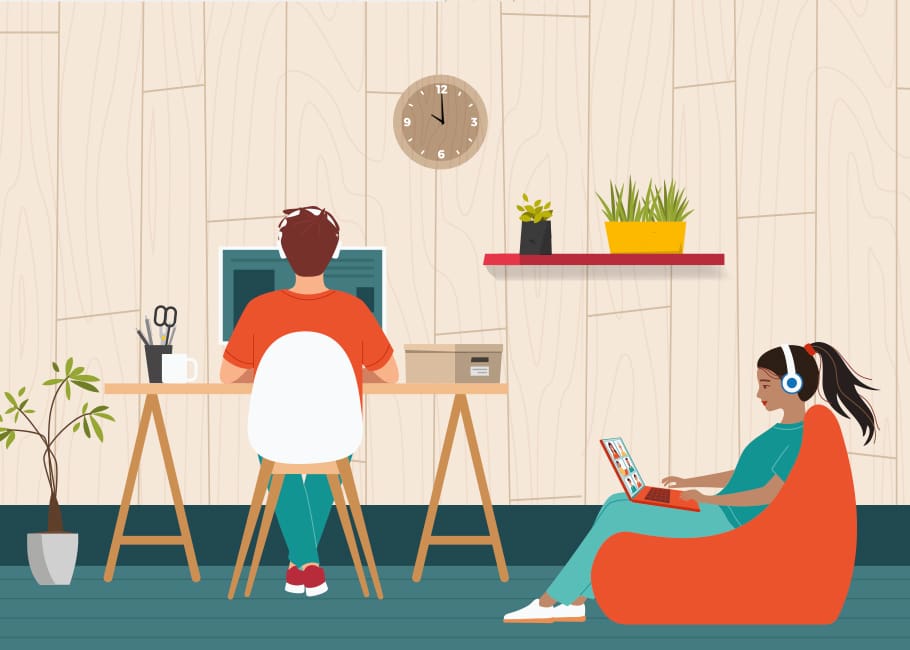
Workspace for two
Tips to successfully share home office space with a partner
The last few years have changed the way we do business, and many brick-and-mortar businesses are making the change to fully remote or hybrid working. In fact, in a recent study by tech communications company Owl Labs, 83% of survey participants who work from home said their productivity is the same as or higher than when they were working in the office.
If you are in this situation (or headed there), one partner in your home may already have an established office space, while the other does not, or both partners may find themselves working from home for all or part of their employment. In both scenarios, couples will have to make adjustments.
Make a game plan
“Sharing a home office with a loved one can be challenging and rewarding,” says Ellie Borden, a registered psychotherapist, clinical director and clinical supervisor of Mind by Design in Oakville, Ontario. “To create a game plan, it is necessary first to identify each person’s needs and work style. One person might need a quieter workplace, while another might need more natural light. Once you know what these needs are, you can plan how to set up the space and equipment to make it a comfortable place to work for both parties. Establishing guidelines and goals with your partner is imperative to ensure a smooth workflow. These guidelines include setting noise levels, scheduling meetings and calls, and respecting each other’s work hours.”
Professional organizer Phaedra Studt, owner of Practical Possibilities in Chicago, agrees. “I work from home when I’m not working with my clients in their homes,” she says. “Pre-pandemic, my husband worked primarily in the office.” She says that when he began working from home, she was initially frustrated because she went from having a quiet place to work, to having her work situation disrupted by countless phone calls that her husband would take. “I could sometimes relocate to another place [in] the home, but my desk had my second monitor and my scanner,” she adds.
The couple came up with solutions. Studt began using noise-cancelling headphones with some music to help her focus. She also let her husband know the days that she would need the office and asked him to relocate for the day. She notes, “I started putting these days on the calendar so he [knew about them] before they came up.”
Practical matters
Studt suggests that a shared home office should have designated individual spaces. “Each person needs to maintain the organization of their own space when it comes to paper management,” she says. “Everyone has different styles for [organizing] their space and accessing their supplies. You will be able to keep the peace if you allow your partner to maintain their space however they deem fit—even if it’s less tidy than you would care for.”
Each partner needs an inbox for incoming household paperwork, according to Studt. She feels that, ideally, each person should have their own desk. If separate workspaces aren’t an option, she says, a surface that can hold a computer with some space to take handwritten notes will suffice. If this is the case, using laptops instead of desktop computers makes it easy for one person to relocate temporarily. Set up communal equipment, such as wireless printers and scanners, outside the office area, where either person can access them without disturbing the other.
Borden says that communication is critical when sharing a home office with a loved one. “Effective communication lets both sides say what they need, what worries them and what they like. This can make the workplace happier and more productive,” she explains. “When discussing office layouts and noise levels, it’s essential to do so with empathy and respect. Begin by expressing your concerns and preferences and acknowledging each other’s needs. You could say, ‘I understand that you need a quiet environment to concentrate, but I also need natural light to work comfortably.’ This demonstrates your willingness to compromise and find a solution for both of you.”
Set boundaries
Don’t rely on assumptions or social norms to dictate your home office culture. Spell it out ahead of time: Are your papers off-limits to your partner—no matter how messy your desk may get?
How do you manage interruptions, or interrupt in a courteous manner? One home worker puts on a headband with ears to warn her partner not to interrupt. Another hangs a “Do Not Disturb” sign on the door. Mutual respect is key.—RWW

EMBASY / STOCK.ADOBE.COM
Keeping the peace
Maintaining a peaceful and productive work environment can be difficult when two people share a home office but work different shifts. Registered psychotherapist Ellie Borden offers some tips to consider:
Use a shared calendar.
A shared calendar can assist you in staying on top of each other’s schedules and avoiding conflicts.Create a communication system.
Determine how you will communicate with one another, especially if one of you is sleeping or working.Make a separate workspace for each person.
This can aid in reducing distractions and interruptions.Schedule breaks together.
Even if you work different shifts, you should take breaks together. This can assist you in remaining connected and reducing feelings of isolation.Rosie Wolf Williams is a freelance writer based in Bennington, Vermont.
Costco Connection: You’ll find a selection of office furniture, laptop and desktop computers, wireless printers and scanners, noise-cancelling earbuds and a host of other supplies for your home office in Costco warehouses and at Costco.ca

